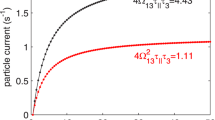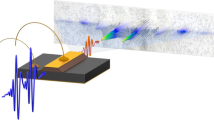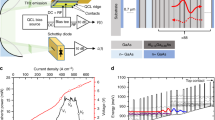Abstract
The understanding of charge carrier distributions is fundamental to our knowledge of laser systems. In semiconductor lasers, because of the propensity of charge carriers to undergo extremely fast momentum relaxation1,2, they accumulate at band extrema—that is, they have a small wavevector close to k ≈ 0 in direct-gap semiconductors. Conventional understanding suggests that the device-level physics occurs at these band extrema, including population inversion for lasing. This behaviour is universal in diode lasers3,4, interband cascade lasers5 and quantum cascade lasers6,7. Here, we report on a quantum cascade laser with an energy configuration able to establish local population inversion high in k-space. We observe dual-wavelength emission from two discrete optical transitions. Temperature-dependent performance attributes show that the two transitions are highly coupled; competition for charge carriers is apparent from the anti correlated behaviour. The two optical transitions represent a conventional quantum cascade laser transition at k ≈ 0 and another laser transition from non-thermal electrons near k ≈ 3.6 × 108 m−1.
This is a preview of subscription content, access via your institution
Access options
Subscribe to this journal
Receive 12 print issues and online access
$209.00 per year
only $17.42 per issue
Buy this article
- Purchase on Springer Link
- Instant access to full article PDF
Prices may be subject to local taxes which are calculated during checkout




Similar content being viewed by others
References
Rudin, S. & Reinecke, T. L. Electron LO-phonon scattering rates in semiconductor quantum wells. Phys. Rev. B 41, 7713–7717 (1990).
Alcalde, A. M. & Weber, G. Nonparabolicity effects on electron-optical-phonon scattering rates in quantum wells. Phys. Rev. B 56, 9619–9624 (1997).
Kroemer, H. Nobel Lecture: Quasielectric fields and band offsets: teaching electrons new tricks. Rev. Mod. Phys. 73, 783–793 (2001).
Alferov, Z. I. Nobel Lecture: The double heterostructure concept and its applications in physics, electronics and technology. Rev. Mod. Phys. 73, 767–782 (2001).
Olafsen, L. J., Vurgaftman, I. & Meyer, J. R. Long-Wavelength Infared Semiconductor Lasers (ed. Choi, H. K.) Ch. 3, 69–143 (Wiley, 2004).
Faist, J. et al. Quantum cascade laser. Science 264, 553–556 (1994).
Gmachl, C., Capasso, F., Sivco, D. L. & Cho, A. Y. Recent progress in quantum cascade lasers and applications. Rep. Prog. Phys. 64, 1533–1601 (2001).
Terazzi, R. et al. Bloch gain in quantum cascade lasers. Nature Phys. 3, 329–333 (2007).
Revin, D. G. et al. Dispersive gain and loss in midinfrared quantum cascade laser. Appl. Phys. Lett. 92, 081110 (2008).
Troccoli, M. et al. Raman injection laser. Nature 433, 845–848 (2005).
Shastin, V. N. Hot hole inter-sub-band transition p-Ge FIR laser. Opt. Quantum Electron. 23, S111–S131 (1991).
Bründermann, E. Long-Wavelength Infared Semiconductor Lasers (ed. Choi, H. K.) Ch. 6, 279–350 (Wiley, 2004).
Pinson, W. E. & Bray, R. Experimental determination of the energy distribution functions and analysis of the energy-loss mechanisms of hot carriers in p-type germanium. Phys. Rev. 136, A1449–A1466 (1964).
Franz, K. J. et al. Evidence of cascaded emission in a dual-wavelength quantum cascade laser. Appl. Phys. Lett. 90, 091104 (2007).
Sirtori, C. et al. Dual-wavelength emission from optically cascaded intersubband transitions. Opt. Lett. 23, 463–465 (1998).
Scalari, G. et al. Electrically switchable, two-color quantum cascade laser emitting at 1.39 and 2.3 THz. Appl. Phys. Lett. 88, 141102 (2006).
Serapiglia, G. B., Vodopyanov, K. L. & Phillips, C. C. Nonequilibrium electron distributions in a three-subband InGaAs/InAlAs quantum well studied via double resonance spectroscopy. Appl. Phys. Lett. 77, 857–859 (2000).
Faist, J. et al. Quantum cascade lasers without intersubband population inversion. Phys. Rev. Lett. 76, 411–414 (1996).
Faist, J. et al. Semiconductors and Semimetals (eds Liu, H. C. & Capasso, F.) Vol. 66, p. 36 (Academic Press, 2000).
Sze, S. Physics of Semiconductor Devices (John Wiley & Sons, 1981).
Sirtori, C., Capasso, F., Faist, J. & Scandolo, S. Nonparabolicity and a sum-rule associated with bound-to-bound and bound-to-continuum intersubband transitions in quantum-wells. Phys. Rev. B 50, 8663–8674 (1994).
Ridley, B. K. Quantum Processes in Semiconductors 4th edn (Oxford Univ. Press, 1999).
Sinning, S. et al. Reduced subpicosecond electron relaxation in GaNxAs1–x . Appl. Phys. Lett. 86, 161912 (2005).
Harrison, P. Quantum Wells, Wires and Dots: Theoretical and Computational Physics of Semiconductor Nanostructures 2nd edn (Wiley, 2005).
Bockelmann, U. & Bastard, G. Phonon scattering and energy relaxation in two-, one- and zero-dimensional electron gases. Phys. Rev. B 42, 8947–8951 (1990).
Acknowledgements
The authors gratefully acknowledge helpful comments, advice and support from J. Chen, F.-S. Choa, S. R. Forrest, S. Gooding, K.-T. Shiu, I. Waldmueller and Y. Yao. This work was supported in part by the Mid-Infrared Technologies for Health and the Environment (MIRTHE) centre (NSF-ERC no. EEC-0540832) and the European Union Marie Curie Research Training Network Physics of Intersubband Semiconductor Emitters (POISE) programme. K.J.F. gratefully acknowledges the support of the National Science Foundation Graduate Research Fellowship Program.
Author information
Authors and Affiliations
Corresponding author
Rights and permissions
About this article
Cite this article
Franz, K., Menzel, S., Hoffman, A. et al. High k-space lasing in a dual-wavelength quantum cascade laser. Nature Photon 3, 50–54 (2009). https://doi.org/10.1038/nphoton.2008.250
Received:
Accepted:
Published:
Issue Date:
DOI: https://doi.org/10.1038/nphoton.2008.250
This article is cited by
-
A 1.8-THz quantum cascade laser operating significantly above the temperature of ℏω/kB
Nature Physics (2011)
-
Lasing high in k-space
Nature Photonics (2009)



